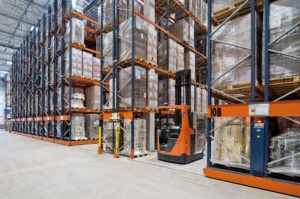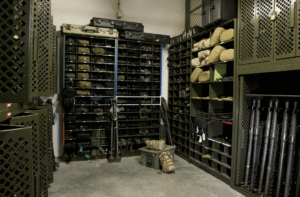Museums serve as the stewards of history, art, science, and culture—guarding priceless collections that require highly specialized storage and compact storage solutions to ensure long-term preservation. But as collections grow, change, and diversify, so do the storage demands of modern museums. That’s where flexible shelving solutions come in.
Flexible museum shelving systems, including art racks, are more than just storage—they’re a critical part of collection care, conservation, accessibility, and space optimization. Whether you’re housing ancient manuscripts, delicate artifacts, artwork, scientific specimens, or mixed media collections, Bradford Systems’ metal shelving solutions provide the modularity, durability, and configuration needed to support museum operations both today and tomorrow.
In this blog, we’ll explore the role of flexible shelving in museum environments, the features and benefits of Bradford Systems’ shelving solutions, and how institutions can future-proof their storage strategy through modular and customizable designs.
The Storage Challenges Museums Face Today
Modern museums face unique and evolving storage challenges:
- Growing collections with limited space for expansion
- Diverse artifact sizes and formats, requiring customized configurations
- Strict conservation requirements to prevent deterioration
- Changing exhibit cycles, requiring access to off-site or on-site storage
- Accessibility and audit control for researchers, conservators, and curators
All of this must be addressed while ensuring safety, security, and optimal use of floor space. Static, one-size-fits-all shelving can’t keep up with these needs. That’s why flexible, modular shelving solutions have become a top priority in museum storage planning.
Flexible Shelving Systems Offered by Bradford Systems
4-Post Shelving: Adjustable, Scalable, and Secure
4-post shelving is one of the most versatile shelving solutions available. Its open design and universal slotting allow for easy customization and adaptation over time.
Key Features:
- Available in single-sided or double-sided configurations
- Universally slotted uprights support a range of accessories
- Adjustable shelves and components with no special tools
- Options for steel, powder-coated, or antimicrobial finishes
- Ideal for both static and high-density mobile systems
Best Used For:
- Artifact crates and archival boxes
- Photographic collections
- Historical documents and records
- Mixed media items
Benefits for Museums:
- Adjustable shelves adapt to new collections or updated storage protocols
- Compatible with bin dividers and drawers for organizing smaller artifacts
- Open-frame design allows for airflow, helping preserve organic materials
Case-Type Shelving: Ideal for Closed Storage or Conservation
When storage requires added containment or aesthetic presentation, case-type shelving is the solution. It features solid side panels and optional backings that help protect sensitive materials.
Key Features:
- Fully enclosed side and back panels
- Clean, finished look appropriate for conservation labs or open archive displays
- Supports drawers, pull-out shelves, and locking doors
- Available in standard or heavy-duty configurations
Best Used For:
- Rare books and manuscripts
- Textiles and costumes (when paired with flat drawers)
- Archival materials in climate-controlled environments
Benefits for Museums:
- Enhanced dust and debris protection for delicate collections
- Structured design improves visual organization for curated storage
- Easily integrates with climate-controlled rooms or vitrines
Cantilever Shelving: Library and Archive Integration
Cantilever shelving is commonly used in museum libraries and reading rooms, where access to books, periodicals, and research materials is essential.
Key Features:
- Side-mounted shelf supports allow full access to the shelf space
- Adjustable shelf height and angle
- Available with canopy tops and footplates for added protection
- Compatible with multimedia storage accessories
Best Used For:
- Museum libraries and resource centers
- Periodicals and bound volumes
- Exhibition preparation spaces
Benefits for Museums:
- Clean, organized display for books and printed media
- Flexible enough for rotating or reclassified collections
- Aesthetic options to match public-facing spaces
Top Reasons Museums Need Flexible Shelving
Optimized Space Utilization
Museum storage rooms, such as those at the Chicago Field Museum, are often constrained by footprint and ceiling height. Flexible shelving allows you to make the most of available space:
- Utilize vertical storage with taller shelving units
- Reconfigure layouts without major structural changes
- Integrate into high-density mobile storage systems for double the capacity
Better Collection Management
Flexible shelving enables museums to:
- Create dedicated zones for different artifact types
- Label and organize for quick retrieval
- Maintain clear pathways and improve workflow for staff
With the ability to add or remove accessories, you can tailor each shelving unit to the unique needs of the items stored.
Preservation of Delicate Items
Museum collections require strict environmental conditions. Flexible metal shelving is built to support:
- Off-the-floor airflow to reduce mold or moisture
- Optional powder-coated or antimicrobial finishes
- Acid-free liners or coated shelves for direct contact items, including museum cabinets that help in keeping collections safe.
The ability to adjust shelf height and accessories also prevents overcrowding or stacking, which can cause permanent damage to artifacts.
Increased Efficiency for Staff and Curators
Time is valuable for museum professionals. Flexible shelving ensures:
- Quick reorganization for new acquisitions or exhibits
- Easy access to stored items
- Better tracking and inventory of stored artifacts
When paired with asset management systems, adjustable shelving supports more efficient audits and collection care.
Integrating Flexible Shelving into High-Density Storage
Bradford Systems’ flexible shelving is fully compatible with high-density mobile storage systems, which are especially valuable in space-constrained museum environments., offering incredible versatility.
Benefits of mobile integration include:
- Elimination of fixed aisles
- Increase in storage capacity by up to 80%
- Reduced need for off-site storage or facility expansion
- Enhanced security with locking mechanisms and aisle access controls
From fragile artifacts to heavy-duty archive boxes, mobile high-density storage with flexible shelving components creates the ultimate space-saving solution.
Museums We Serve
Bradford Systems works with museums of all sizes—from major institutions to specialized galleries—to create tailored shelving solutions that protect their collections and optimize their workflows.
We’ve supported storage designs for:
- Art museums with rotating exhibits
- Natural history museums with oversized specimens
- Historical societies with fragile, paper-based archives
- University museums with student-accessible storage
- Science museums with specialized preservation needs
Our experts collaborate with museum professionals to understand:
- Collection types and growth projections
- Climate control requirements
- ADA and accessibility standards
- Staff workflow and curatorial access
- Fire code and insurance compliance
Conclusion: Flexible Shelving is the Foundation of Smart Museum Storage
The objects that museums preserve today will educate and inspire generations to come. To ensure these treasures stand the test of time, your storage infrastructure must be just as thoughtful and enduring. Flexible shelving from Bradford Systems provides the adaptability, durability, and intelligence modern museums need to protect collections while keeping up with changing operational demands.
Whether you’re redesigning your storage areas, outfitting a new facility, or simply looking to expand your current system, Bradford Systems is here to help you build smarter, safer, and more efficient museum storage.
Contact us today to speak with a storage expert and explore how our flexible shelving systems can transform your collection management.






